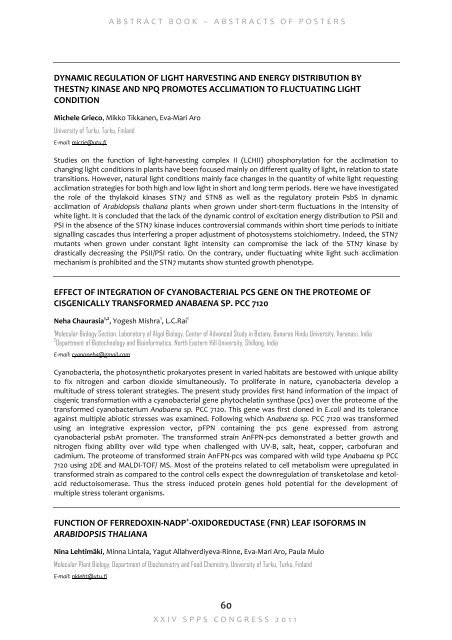1. Front Cover.cdr - CORE
1. Front Cover.cdr - CORE
1. Front Cover.cdr - CORE
Create successful ePaper yourself
Turn your PDF publications into a flip-book with our unique Google optimized e-Paper software.
A B S T R A C T B O O K – A B S T R A C T S O F P O S T E R S<br />
DYNAMIC REGULATION OF LIGHT HARVESTING AND ENERGY DISTRIBUTION BY<br />
THESTN7 KINASE AND NPQ PROMOTES ACCLIMATION TO FLUCTUATING LIGHT<br />
CONDITION<br />
Michele Grieco, Mikko Tikkanen, Eva-Mari Aro<br />
University of Turku, Turku, Finland<br />
E-mail: micrie@utu.fi<br />
Studies on the function of light-harvesting complex II (LCHII) phosphorylation for the acclimation to<br />
changing light conditions in plants have been focused mainly on different quality of light, in relation to state<br />
transitions. However, natural light conditions mainly face changes in the quantity of white light requesting<br />
acclimation strategies for both high and low light in short and long term periods. Here we have investigated<br />
the role of the thylakoid kinases STN7 and STN8 as well as the regulatory protein PsbS in dynamic<br />
acclimation of Arabidopsis thaliana plants when grown under short-term fluctuations in the intensity of<br />
white light. It is concluded that the lack of the dynamic control of excitation energy distribution to PSII and<br />
PSI in the absence of the STN7 kinase induces controversial commands within short time periods to initiate<br />
signalling cascades thus interfering a proper adjustment of photosystems stoichiometry. Indeed, the STN7<br />
mutants when grown under constant light intensity can compromise the lack of the STN7 kinase by<br />
drastically decreasing the PSII/PSI ratio. On the contrary, under fluctuating white light such acclimation<br />
mechanism is prohibited and the STN7 mutants show stunted growth phenotype.<br />
EFFECT OF INTEGRATION OF CYANOBACTERIAL PCS GENE ON THE PROTEOME OF<br />
CISGENICALLY TRANSFORMED ANABAENA SP. PCC 7120<br />
Neha Chaurasia 1,2 , Yogesh Mishra 1 , L.C.Rai 1<br />
1 Molecular Biology Section, Laboratory of Algal Biology, Center of Advanced Study in Botany, Banaras Hindu University, Varanasi, India<br />
2 Department of Biotechnology and Bioinformatics, North Eastern Hill University, Shillong, India<br />
E-mail: cyanoneha@gmail.com<br />
Cyanobacteria, the photosynthetic prokaryotes present in varied habitats are bestowed with unique ability<br />
to fix nitrogen and carbon dioxide simultaneously. To proliferate in nature, cyanobacteria develop a<br />
multitude of stress tolerant strategies. The present study provides first hand information of the impact of<br />
cisgenic transformation with a cyanobacterial gene phytochelatin synthase (pcs) over the proteome of the<br />
transformed cyanobacterium Anabaena sp. PCC 7120. This gene was first cloned in E.coli and its tolerance<br />
against multiple abiotic stresses was examined. Following which Anabaena sp. PCC 7120 was transformed<br />
using an integrative expression vector, pFPN containing the pcs gene expressed from astrong<br />
cyanobacterial psbA1 promoter. The transformed strain AnFPN-pcs demonstrated a better growth and<br />
nitrogen fixing ability over wild type when challenged with UV-B, salt, heat, copper, carbofuran and<br />
cadmium. The proteome of transformed strain AnFPN-pcs was compared with wild type Anabaena sp PCC<br />
7120 using 2DE and MALDI-TOF/ MS. Most of the proteins related to cell metabolism were upregulated in<br />
transformed strain as compared to the control cells expect the downregulation of transketolase and ketolacid<br />
reductoisomerase. Thus the stress induced protein genes hold potential for the development of<br />
multiple stress tolerant organisms.<br />
FUNCTION OF FERREDOXIN-NADP + -OXIDOREDUCTASE (FNR) LEAF ISOFORMS IN<br />
ARABIDOPSIS THALIANA<br />
Nina Lehtimäki, Minna Lintala, Yagut Allahverdiyeva-Rinne, Eva-Mari Aro, Paula Mulo<br />
Molecular Plant Biology, Department of Biochemistry and Food Chemistry, University of Turku, Turku, Finland<br />
E-mail: nkleht@utu.fi<br />
60<br />
X X I V S P P S C O N G R E S S 2 0 1 1


